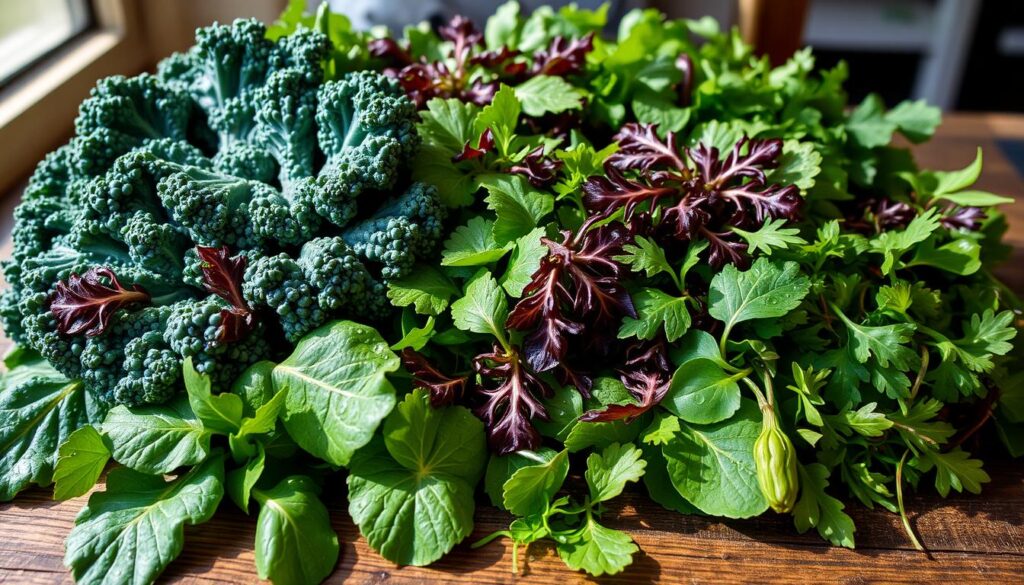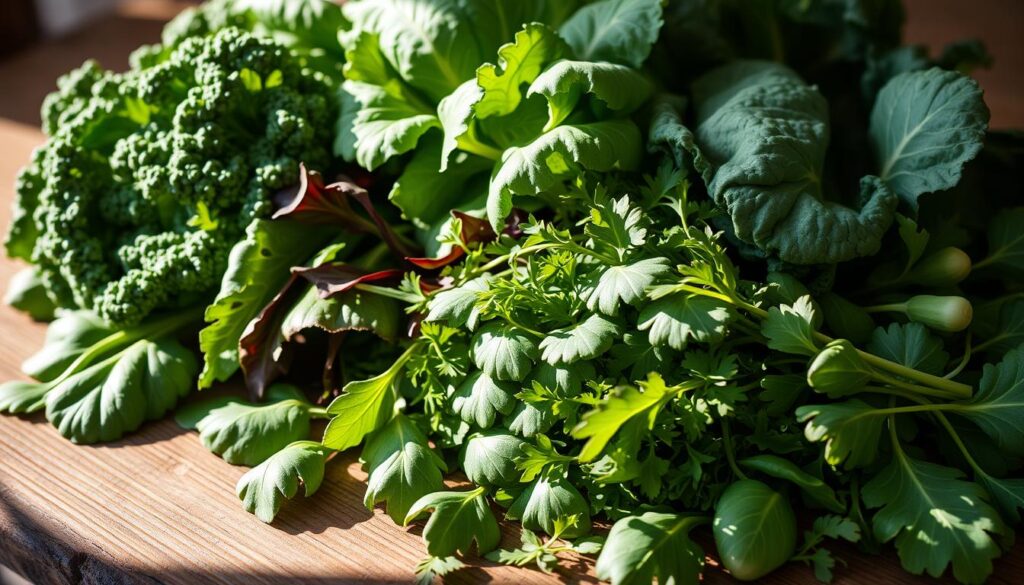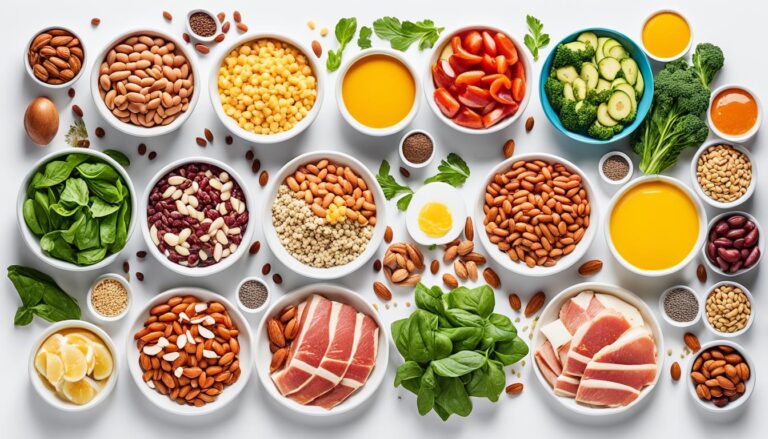Did you know the average American eats only about 1.5 pounds of spinach per year? That’s a tiny part of what this leafy green can offer. But what if I told you eating more greens could make you healthier? It could protect you from chronic diseases, boost your brain, and improve your gut health. Would you give it a try?
Key Takeaways
- Leafy greens are full of vitamins, minerals, and antioxidants that are good for your health.
- Eating more greens can help lower blood pressure, improve brain function, and better your gut health.
- Greens are low in calories but high in fiber, helping with weight management.
- Spinach is a nutritional superstar, packed with vitamins K, A, and folate.
- Adding more leafy greens to your diet is an easy way to increase your nutrient intake.
The Incredible Nutritional Power of Leafy Greens
Leafy greens are top superfoods. They include spinach, kale, and more. These cruciferous greens are full of vitamins, minerals, and other good stuff. They help keep you healthy and feeling great.
Spinach: A Nutritional Powerhouse
Spinach is full of vitamins K, A, and C. It also has folate, manganese, magnesium, and iron. One cup of raw spinach gives you 121% of the daily value for vitamin K and 16% for vitamin A.
This green is also packed with antioxidants like carotenoids. These help protect your cells from damage.
Kale and Other Cruciferous Greens
Kale and other cruciferous greens like broccoli and Brussels sprouts are also super nutritious. One cup of raw kale has 68% of the daily value for vitamin K, 6% for vitamin A, and 22% for vitamin C.
These greens are also rich in fiber, vitamins, and phytochemicals. They may help lower the risk of chronic diseases.
| Leafy Green | Nutrient Highlights |
|---|---|
| Spinach | 121% DV for vitamin K, 16% DV for vitamin A |
| Kale | 68% DV for vitamin K, 6% DV for vitamin A, 22% DV for vitamin C |
| Collard Greens | 131% DV for vitamin K, 16% DV for vitamin A, 33% DV for vitamin C |
| Beet Greens | 127% DV for vitamin K, 13% DV for vitamin A, 12% DV for vitamin C |
| Watercress | 71% DV for vitamin K, 17% DV for vitamin C, 6% DV for vitamin A |
Leafy greens are great for boosting your nutrient intake. They support your immune system and add wholesome foods to your diet. They’re a key part of a healthy lifestyle.

Leafy Greens: Nature’s Disease-Fighting Superfoods
Leafy greens are full of antioxidants and phytochemicals. These compounds protect against many health issues. They help fight free radicals, lowering the risk of diseases like cancer and Alzheimer’s.
Rich in Antioxidants and Phytochemicals
Spinach has alpha-lipoic acid, which helps control blood sugar and insulin. Kale and collard greens are also good for you. They have vitamin C, vitamin K, and more, boosting your immune system.
| Nutrient | Benefits |
|---|---|
| Antioxidants | Protect against cell damage and reduce the risk of chronic diseases |
| Phytochemicals | Help defend the body against bacteria, fungi, parasites, and viruses |
| Vitamin C | Support immune function and promote skin health |
| Vitamin K | Maintain healthy blood vessels, reduce heart disease risk, and support cognitive function |
Eating more leafy greens can help you fight diseases. It’s a simple way to improve your health and well-being.

“Leafy greens are a treasure trove of antioxidants and phytochemicals that can help prevent a variety of chronic conditions. Incorporating them into your daily routine is a simple and effective way to boost your body’s natural defenses.”
Lowering Blood Pressure with Greens
Leafy greens are a powerhouse for managing blood pressure. They are packed with potassium, which relaxes blood vessels and lowers blood pressure. They also have magnesium and folate, helping to make nitric oxide. This molecule widens blood vessels and eases heart strain.
Research shows that drinking spinach can lower blood pressure for up to 5 hours. This highlights the amazing effect leafy greens have on heart health. Studies also find that eating more fruits and veggies, especially leafy greens, can greatly lower high blood pressure risk.
| Food | Potential Blood Pressure Benefits |
|---|---|
| Spinach | Lowers blood pressure for up to 5 hours after consumption |
| Kale | High in nitrates, which help dilate blood vessels |
| Broccoli | Consumption linked to a lower risk of high blood pressure |
| Beets | High in nitrates, which can reduce systolic blood pressure |
| Blueberries | Contain anthocyanins, which may help lower blood pressure |
Eating more leafy greens and other nutrient-rich fruits and veggies can help keep blood pressure healthy. This simple change can support your heart health and lower heart disease risk. By doing this, you’re taking a big step towards better heart health.

Boosting Brain Health and Memory
Eating more leafy greens can greatly improve your brain health and memory. These veggies are packed with antioxidants, folate, and vitamin K. They help protect brain cells and may slow down memory loss as we age.
One study showed that eating half a cup of cooked spinach or other greens every day can slow down brain decline. The nutrients in these greens may also lower Alzheimer’s risk. They do this by stopping harmful proteins in the brain and reducing inflammation.
Leafy greens like spinach, kale, and collards are full of brain-boosting compounds. They have antioxidants, folate, and vitamin K. These nutrients are key for keeping your brain sharp, your memory strong, and your brain healthy.
“Higher intake of nutrients and bioactives in green leafy vegetables, except β-carotene, were individually associated with slower cognitive decline.”
But leafy greens aren’t the only brain-healthy foods. Other foods include:
- Blueberries, which boost blood flow and oxygen to the brain
- Apples, which stimulate new neuron production
- Broccoli, rich in sulforaphane with anti-inflammatory properties
- Tomatoes, with antioxidants like lycopene and beta-carotene that support brain function
Eating a variety of these brain-boosting foods can protect your brain. It can help keep your memory sharp and lower your risk of diseases like Alzheimer’s.

7 Reasons to Eat More GREENS
Leafy greens are full of nutrients, offering many health benefits. They boost energy, metabolism, and brain function. They also help with eye health and fertility. Adding more greens to your diet is a simple way to get healthier.
- Nutrient-Dense and Low in Calories: Greens like spinach, kale, and collards are full of vitamins and minerals. They are also low in calories, making them great for weight management or a healthy snack.
- Disease Prevention: The phytochemicals and antioxidants in greens can lower the risk of chronic diseases. This includes cancer, Alzheimer’s, and autoimmune conditions.
- Heart Health: Greens are rich in potassium, which helps control blood pressure. This keeps your heart healthy.
- Brain Booster: The folate, vitamin K, and nitrates in greens improve brain function and memory. They also boost cognitive performance.
- Gut Health Promotion: Greens are high in fiber, which supports a healthy gut. This improves digestion.
- Iron Absorption: Vitamin C in greens helps the body absorb iron better. This supports healthy blood and energy levels.
- Eye Protection: Greens like kale and spinach have lutein and zeaxanthin. These antioxidants protect the eyes from age-related diseases.
Eating more greens is a simple way to improve your health. You can enjoy them raw, blended, or cooked. Leafy greens are a great addition to any healthy diet.

| Nutrient | Health Benefits |
|---|---|
| Vitamin A | Supports eye health, immune function, and skin health |
| Vitamin C | Boosts immunity, enhances iron absorption, and promotes collagen production |
| Vitamin K | Supports bone health and blood clotting |
| Folate | Promotes healthy fetal development and red blood cell formation |
| Calcium | Maintains strong bones and teeth |
| Magnesium | Supports muscle and nerve function, and energy production |
Adding a variety of leafy greens to your diet is a simple way to boost your health. Enjoy them raw, blended, or cooked. Greens are a great addition to any healthy lifestyle.
Improving Gut Health with Fiber-Rich Greens
Fiber is key for a healthy gut, and leafy greens are a great source. They add bulk to your stool, helping prevent constipation. This makes digestion regular and can help with weight management by keeping you full longer.
Spinach, kale, and collards are full of fiber and prebiotics. These feed the good bacteria in your gut. This helps improve your gut health and supports a diverse microbiome.
Studies show that eating more fiber can change your gut bacteria in just five days. Since most people don’t get enough fiber, adding greens to your diet is a simple way to increase it. This can greatly benefit your gut.
- Jerusalem artichokes contain 47 grams of the prebiotic fiber fructan per cup.
- Leeks provide 10 grams of fructan in a single leek.
- Onions offer 9 grams of fructan per cup.
- Raspberries contain 6 grams of fructan per cup.
Eating fiber-rich greens and other high-fiber foods can nourish your gut. It supports healthy digestion and brings many benefits of a thriving microbiome.
“Upping fiber intake can improve gut bacteria quickly, sometimes in as little as five days, according to a study in the journal Nature.”
Enhancing Iron Absorption for Healthy Blood
Keeping iron levels healthy is key for feeling good. Iron deficiency can cause anemia and other health problems. Leafy greens are packed with non-heme iron, great for a plant-based diet. But, some greens have compounds that block iron absorption.
Non-Heme Iron and Vitamin C
To get the most iron from greens, eat them with vitamin C foods like citrus fruits, berries, or potatoes. Vitamin C boosts iron absorption. Adding these foods to your meals helps fight iron deficiency and keeps blood flowing well.
| Nutrient | Recommended Daily Intake | Food Sources |
|---|---|---|
| Iron |
|
|
| Vitamin C |
|
|
Eating a mix of iron-rich and vitamin C-rich foods helps your body absorb iron better. This supports healthy blood and overall health.
Protecting Eyesight with Lutein and Zeaxanthin
Lutein and zeaxanthin are key for healthy eyes. They are found in leafy greens like spinach and kale. These compounds are related to vitamin A and beta-carotene.
Eating foods rich in lutein and zeaxanthin can protect eyes from sun damage. It may also lower the risk of cataracts and macular degeneration. A study showed that spinach can boost eye health and vision.
Most Americans get only 1-2 mg of lutein and zeaxanthin daily. But research suggests 10 mg lutein and 2 mg zeaxanthin are more effective. Spinach is packed with 7,450 mcg of lutein per 100 g.
Protecting eyes from free radicals is vital. Studies show that fighting these agents can protect the retina. A woman with glaucoma who took 20 mg/day of lutein for eight years saw benefits.
The European Food Safety Authority has set a limit for zeaxanthin intake. The FDA considers lutein and zeaxanthin supplements safe. But more research is needed on their long-term effects.
Eating more leafy greens and vegetables can protect your eye health. These nutrients show the power of a diet full of greens. They are a key to reducing age-related eye disorders.
Raw or Cooked: How to Maximize Nutrient Intake
When it comes to leafy greens, the debate on raw vs cooked is common. Both methods have their own nutrient benefits. Knowing these differences helps you enjoy these veggies to the fullest.
Nutrient Variations in Cooking Methods
Cooked spinach has more calcium, vitamin A, carotenoids, fiber, iron, protein, and zinc than raw spinach. Raw spinach, however, keeps more folate, lutein, and vitamin C. A 2019 study showed that steaming kale best preserves its nutrients.
| Nutrient | Raw Spinach | Cooked Spinach |
|---|---|---|
| Calcium | 30 mg | 245 mg |
| Vitamin A | 2,813 IU | 11,458 IU |
| Fiber | 2.2 g | 4.3 g |
| Iron | 0.8 mg | 3.6 mg |
| Protein | 0.9 g | 4.3 g |
Enjoying both raw and cooked leafy greens maximizes your nutrient intake. Mixing both in your meals boosts your intake of vitamins, minerals, and antioxidants.
“Steaming vegetables can be a good way to maintain their nutrients and avoid adding fats from oils or butter.”
Greens for a Healthy Lifestyle
Adding more leafy greens to your balanced diet is great for a healthy lifestyle. They are low in calories but rich in fiber, vitamins, and minerals. This can increase your energy, improve digestion, and help with healthy weight management. Including greens in your plant-based nutrition plan can bring many health benefits and keep you feeling your best.
Arugula is packed with more nutrients than carrots, tomatoes, and sweet potatoes. Spinach has just 41 calories and over 4 grams of fiber per cup cooked. Kale is full of calcium, potassium, and vitamins A, K, B6, and C. Collard greens have a lot of vitamin A, too.
To get the most from leafy greens, try to eat at least 1 1/2 to 2 cups a week. Raw greens have more vitamin C, but cooking can boost calcium levels. Some greens, like spinach and kale, have a lot of vitamin K. This can affect blood-thinning drugs.
Having a variety of greens in your healthy lifestyle offers many nutritional benefits. They support brain health, weight management, gut health, and eye health. By making greens a staple in your balanced diet, you can enjoy their many advantages and stay healthy.
“Greens are low in calories, high in fiber and essential vitamins and minerals, and can help boost energy levels, improve digestion, and support healthy weight management.”
Conclusion
Leafy green vegetables are full of vitamins, minerals, antioxidants, and fiber. Adding spinach, kale, and collard greens to your meals can boost your health. They help lower blood pressure, improve brain function, protect your eyes, and keep your gut healthy.
Studies link eating more fruits and veggies, especially leafy greens, to less heart disease, cancer, and diabetes. The DASH diet, rich in greens, also lowers blood pressure in people with high blood pressure.
As the world’s population ages, eating well becomes more important. Leafy greens can help older people live longer and avoid chronic diseases. By eating leafy greens regularly, you can stay healthy and vibrant for years to come.





